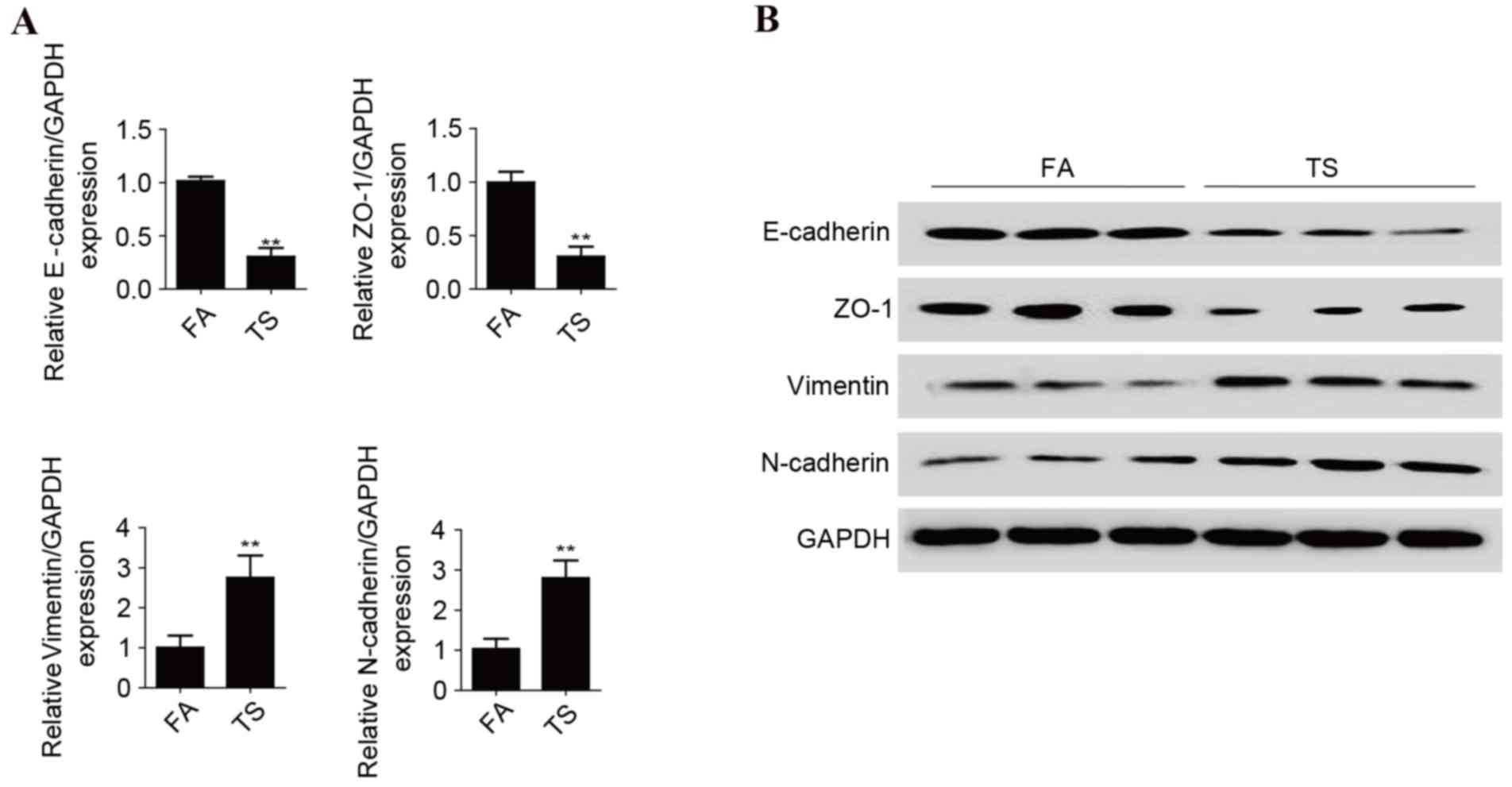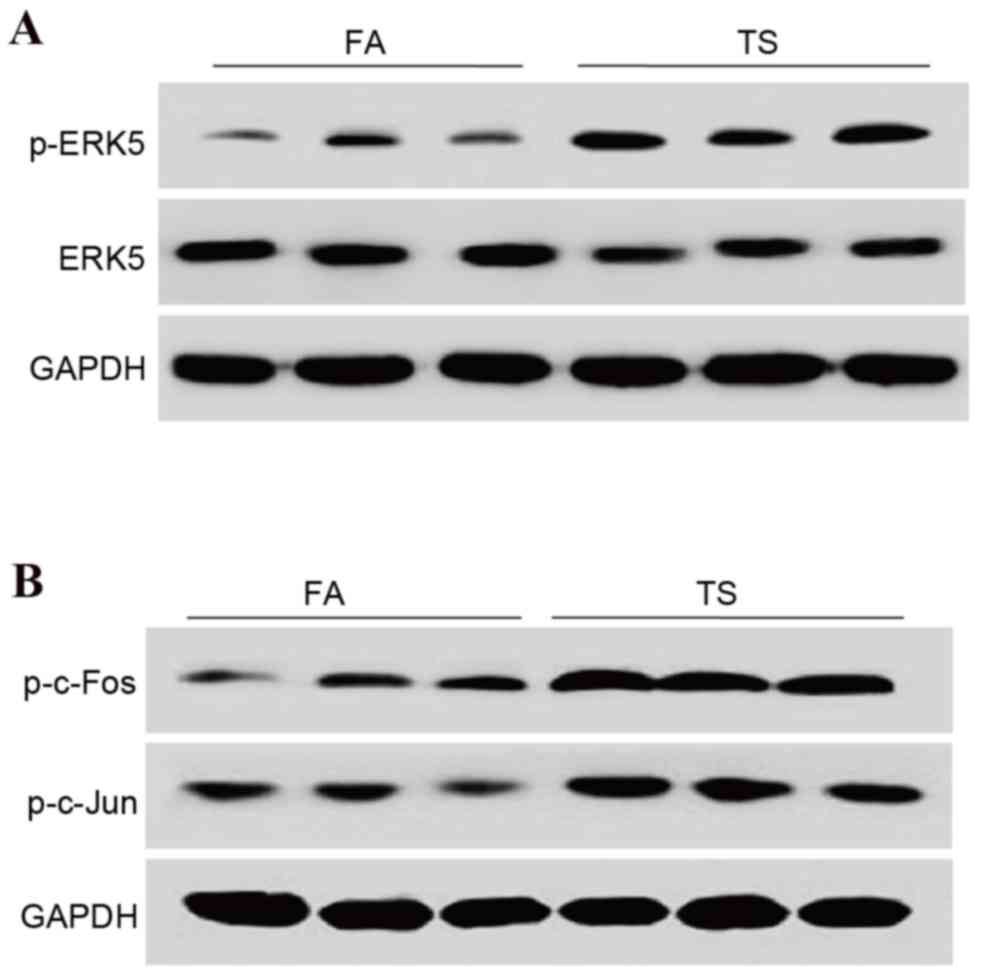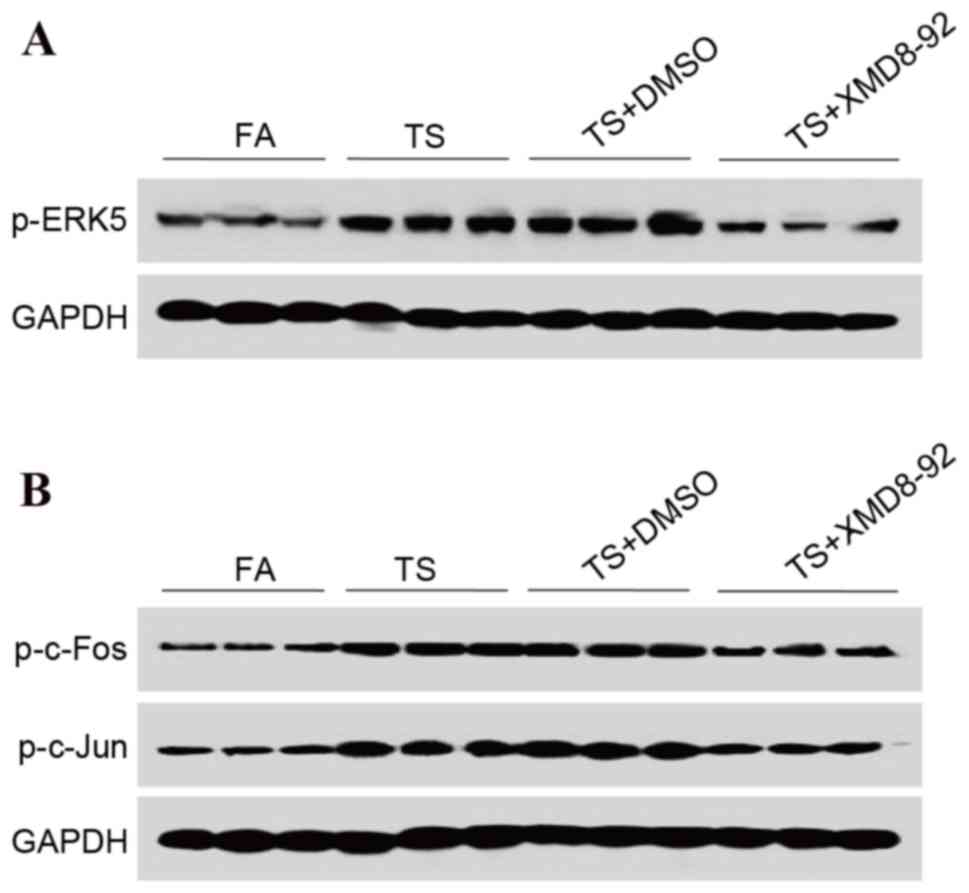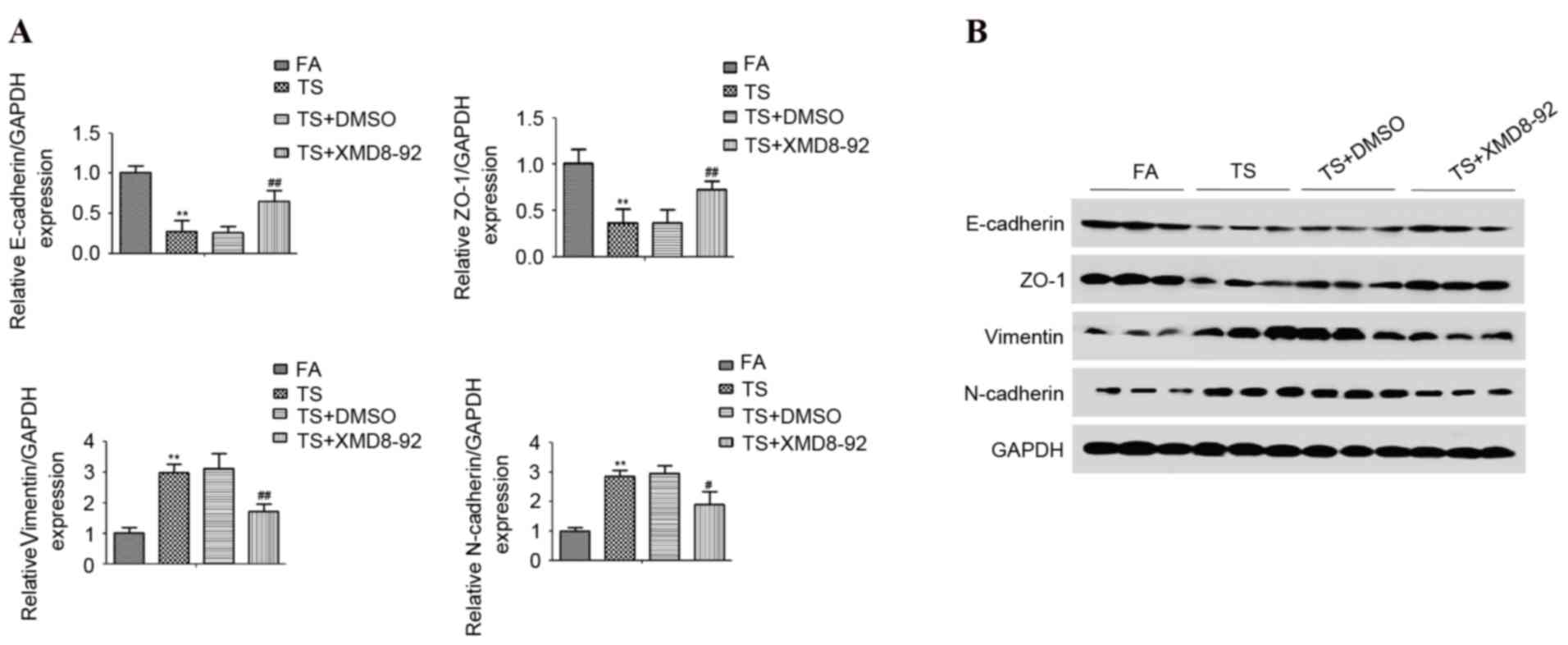ERK5 regulates tobacco smoke‑induced urocystic epithelial‑mesenchymal transition in BALB/c mice
- Authors:
- Published online on: April 11, 2017 https://doi.org/10.3892/mmr.2017.6457
- Pages: 3893-3897
Abstract
Introduction
Bladder cancer (BC) is the fifth most common type of malignant tumor worldwide (1) and one of the most frequently occurring in the urinary system. It is predominantly present in Europe, North America and Australia, with approximately 420,000 newly diagnosed cases each year and a leading cause of cancer-associated mortality (2,3). Of all urinary malignancies, BC is the primary cause of mortality in China (4,5).
A number of studies have revealed that tobacco smoke (TS), the environment and diet are primary risk factors for BC, in addition to drinking water contaminants, including chlorinated byproducts and arsenic, the use of pioglitazone, obesity, hypertension and diabetes (2,6,7). A previous study reported that 23% of female and 50% of male BC cases have been attributed to TS (8). It has been reported that current tobacco smokers have a fourfold greater risk of developing BC, compared with non-smokers (9). Progress in the understanding of the molecular mechanisms underlying the initiation and progression of BC has been made; however, the molecular pathogenesis remains to be fully elucidated.
Epithelial-mesenchymal transition (EMT) is an important mechanism in embryonic progression and cancer development (10). Cells progressively lose their epithelial characteristics and acquire mesenchymal features during the process of EMT (11). In addition to facilitating tumor invasion and metastasis, EMT is also involved in the initiation of tumorigenesis by promoting cell malignant transformation. TS has been previously demonstrated to promote the initial progression of EMT (12–14). TS-triggered EMT has been revealed to regulate early events in carcinogenesis, including downregulation of E-cadherin, loss of cell-cell adhesion and increased mobility of cells. However, the underlying molecular mechanisms by which TS induces EMT remain to be fully elucidated.
Extracellular signal-regulated kinase (ERK) 5 is the least studied member of the mitogen-activated protein kinase (MAPK) family, and is implicated in important cellular processes, including gene expression, proliferation, apoptosis, angiogenesis, cell motility and differentiation (15–18). A number of studies have investigated the functional role of ERK5 in cancer oncogenesis; however, its role in EMT regulation requires further investigation. It has been reported that ERK5 promotes EMT (19–21) and triggers a motility and invasive phenotype of cells (22–24). Additional studies have suggested a differential regulatory role of ERK5 in EMT (25,26).
The present study, to the best of our knowledge, is the first to investigate the role of ERK5 in TS-induced urocystic EMT in vivo. The study was designed to investigate ERK5 regulation of TS-induced EMT in bladder tissue of mice, using in vivo TS exposure models. The findings of the present study suggest that ERK5 may regulate TS-mediated urocystic EMT and provide insight into the underlying molecular mechanisms of TS-associated bladder tumorigenesis.
Materials and methods
Chemicals and reagents
XMD8-92 was purchased from Tocris Bioscience (Bristol, UK). Primary antibodies, phosphorylated (p)-ERK5 (cat. no. 3371S), p-c-Jun (cat. no. 9164S), p-c-Fos (cat. no. 5348), E-cadherin (cat. no. 3195S), N-cadherin (cat. no. 4061) and Vimentin (cat. no. 3932S) were all obtained from Cell Signaling Technology, Inc. (Danvers, MA, USA). Antibodies for zonula occludens (ZO)-1 (cat. no. sc-8146) and GAPDH (cat. no. sc-20357) were from Santa Cruz Biotechnology, Inc. (Dallas, TX, USA). Primers for E-cadherin, ZO-1, N-cadherin, Vimentin and GAPDH were synthesized by Invitrogen; Thermo Fisher Scientific, Inc. (Waltham, MA, USA).
Mice and TS exposure
Male BALB/c mice (weight, 18–22 g; age, 8 weeks; n=12) were purchased from the Animal Research Center of Nanjing Medical University (Nanjing, China). Mice were group-housed in polypropylene cages, maintained on a 12 h light/dark cycle, at 22±0.5°C room temperature, at 40–60% humidity with free access to water and the AIN-76A diet. Animals were handled in accordance with the recommendations in the guidelines of the Animal Care and Welfare Committee of Nanjing Medical University. The present study protocol was approved by the Committee of the Ethics of Animal Experiments of Nanjing Medical University.
The control group (n=6) was exposed to filtered air (FA), and the TS-exposure group (n=6) was exposed to TS in a smoking apparatus designed by the authors. One commercial cigarette (Hongtashan, one of the most consumed cigarettes in China, which contains 12 mg tar and 1.1 mg nicotine per cigarette) was combusted to generate TS by a smoke machine at a constant rate (each cigarette took ~5 min to burn out). The smoke was delivered to whole-body exposure chambers with a target concentration of total particulate matter (TPM) of 80 mg/m3. Mice were exposed for 6 h daily for 12 weeks. Exposures were monitored and characterized as follows: For the control group, carbon monoxide was at 13.98±2.65 mg/m3 and TPM was at 0 mg/m3; and for the TS-exposure group, carbon monoxide was at 168.77±19.36 mg/m3 and TPM was at 81.05±3.82 mg/m3. Following the final TS exposure, mice were sacrificed by exposure to 20% CO2 and the bladder tissues were isolated, frozen and stored at −80°C until analysis.
Delivery of ERK5 inhibitor in mice
A total of 24 mice were divided into four groups (n=6/group) as follows: i) FA-exposure group, in which mice were exposed to FA; ii) TS-exposure group, in which mice were exposed to TS; iii) TS + dimethyl sulfoxide (DMSO) group, in which mice were injected with 15 µl DMSO and exposed to TS; and iv) TS + XMD8-92, in which mice were injected with XMD8-92 and exposed to TS. XMD8-92 was reconstituted in DMSO and injected intraperitoneally (2 mg/kg body weight) every other day. Mice were weighed weekly. Following the completion of exposure, mice were sacrificed and bladder tissues were collected for analysis.
Western blot analysis
Proteins were extracted from bladder tissues (~200 mg) using a lysate buffer (5 mmol/l EDTA, 50 mmol/l Tris, 1% SDS, pH 7.5, 10 µg/ml aprotinin, 1% sodium deoxycholate, 1% NP-40, 1 mM PMSF, 1% Triton-X 100, and 10 µg/ml leupeptin). Protein concentrations were quantified using a BCA Protein Assay kit (Pierce; Thermo Fisher Scientific, Inc.). Protein (60 µg/lane) was loaded on 10% SDS-PAGE and then transferred to polyvinylidene membranes (EMD Millipore, Billerica, MA, USA). The membranes were blocked by 5% (w/v) non-fat milk for 1 h at room temperature and subsequently probed with primary antibodies p-ERK5 (1:500), p-c-Jun (1:500), p-c-Fos (1:500), E-cadherin (1:1,000), N-cadherin (1:500), Vimentin (1:1,000) and ZO-1 (1:500), GAPDH (1:5,000) overnight at 4°C, and then incubated with a horseradish peroxidase-conjugated goat anti-mouse (1:5,000) and goat anti-rabbit (1:10,000) secondary antibodies. Immunoreactive bands were detected by enhanced chemiluminescence (GE Healthcare Life Sciences, Chalfont, UK).
Reverse transcription-quantitative polymerase chain reaction (RT-qPCR)
RNA was isolated from frozen bladder tissues (~100 mg) using the RNAiso Plus kit according to the manufacturer's protocol (Takara Bio, Inc., Otsu, Japan). RNA (2 µg) was reverse transcribed into cDNA using AMV Reverse Transcriptase (Promega Corporation, Madison, WI, USA). cDNA was analyzed by PCR using the Power SYBR-Green Master Mix (Takara Bio, Inc.). The thermal cycling profile for PCR was 94°C for 5 min, followed by 36 cycles of 30 sec at 94°C, with 30 sec annealing intervals at their correct temperatures (56–60°C) and 30 sec at 72°C. The primers used were as follows: E-cadherin, forward 5′-TCGACACCCGATTCAAAGTGG-3′, reverse 5′-TTCCAGAAACGGAGGCCTGAT-3′; ZO-1, forward 5′-GCAGCCACAACCAATTCATAG-3′, reverse 5′-GCAGACGATGTTCATAGTTTC-3′; Vimentin, forward 5′-CCTTGACATTGAGATTGCCA-3′, reverse 5′-GTATCAACCAGAGGGAGTGA-3′; N-cadherin, forward 5′-ATCAAGTGCCATTAGCCAAG-3′, reverse 5′-CTGAGCAGTGAATGTTGTCA-3′; and GAPDH, forward 5′-GCTGCCCAACGCACCGAATA-3′, reverse 5′-GAGTCAACGGATTTGGTCGT-3′; GAPDH served as a control. Fold alterations in gene expression were calculated by a comparative threshold cycle (Cq) method using the formula 2−ΔΔCq (27,28).
Statistical analysis
Data are expressed as the mean ± standard deviation. Statistical analyses were performed with SPSS software, version 16.0 (SPSS, Inc., Chicago, IL, USA). One-way analysis of variance was used for comparison of statistical differences of multiple groups, followed by the least significant difference test. An unpaired Student's t-test was used for the comparison between two groups. P<0.05 was considered to indicate a statistically significant difference.
Results
TS exposure alters the expression of EMT markers in bladder tissues of mice
TS is one of the key risk factors for BC, and TS-induced EMT is important in TS-associated malignant transformation. The present study investigated whether TS exposure induces EMT in bladder tissues. BALB/c mice were exposed to TS for 12 weeks, and the expression of the epithelial and mesenchymal markers in the bladders of mice were examined. RT-qPCR results revealed that TS exposure decreased the mRNA expression levels of E-cadherin and ZO-1. Conversely, the mRNA expression levels of Vimentin and N-cadherin were increased (P<0.01 vs. FA control; Fig. 1A). TS exposure reduced E-cadherin and ZO-1 protein expression levels, and elevated Vimentin and N-cadherin protein levels, as demonstrated by western blot analysis (Fig. 1B).
TS increases ERK5/activator protein (AP)-1 activation in bladder tissue
To determine if TS-induced bladder EMT alterations are associated with ERK5 activation, the expression levels of p-ERK5 were measured. It was demonstrated that TS exposure activated the urocystic ERK5 pathway (Fig. 2A). TS exposure also increased AP-1 protein expression in the bladder of mice, as indicated by elevated levels of p-c-Jun and p-c-Fos (Fig. 2B). The data therefore suggested that ERK5 activity may be important in TS-elicited EMT in bladder tissue.
XMD8-92 attenuates TS-induced ERK5 activation in bladder tissue
The aforementioned results revealed that TS-induced urocystic EMT was associated with ERK5 activation; therefore, the present study aimed to further determine the role of ERK5 in urocystic EMT regulation. Mice were treated with XMD8-92 (2 mg/kg body weight), a highly specific ERK5 inhibitor that suppresses ERK5 activation. Western blot analyses revealed that XMD8-92 downregulated p-ERK5 expression levels (Fig. 3A). In addition, treatment with XMD8-92 markedly decreased TS-induced AP-1 activation (Fig. 3B).
ERK5 suppression reverses TS-triggered urocystic EMT
To further determine the role of ERK5 in TS-triggered EMT in the bladder tissue of mice, the expression of the EMT markers were examined. ERK5 suppression reversed TS-induced alterations in the mRNA levels of E-cadherin, ZO-1, Vimentin (P<0.01 vs. FA control; P<0.001 vs. TS) and N-cadherin (P<0.01 vs. FA control; P<0.05 vs. TS; Fig. 4A). Western blot analyses demonstrated that XMD8-92 treatment attenuated both the TS-induced decrease of E-cadherin and ZO-1 levels, and the increase of Vimentin and N-cadherin in the bladders of the mice (Fig. 4B). These data demonstrated the regulatory role of ERK5 in TS-induced EMT in the bladder tissue.
Discussion
BC is one of the primary causes of cancer-associated mortality, and an association between the occurrence of BC and TS has previously been established (27,29). However, the underlying molecular mechanisms by which TS results in BC development remain to be fully elucidated. The present study demonstrated that TS exposure induced EMT in the bladder of mice. To the best of our knowledge, the present study is the first to demonstrate that ERK5 regulates TS-mediated bladder EMT in vivo. The findings suggested that exposure to TS elevated ERK5 activation, and TS-associated bladder EMT alteration was reversed by ERK5 inhibition. These results explain the important role of ERK5 in TS-triggered urocystic EMT and furthers our current understanding of the underlying molecular mechanisms of TS-associated BC.
It has previously been demonstrated that exposure of cells to carcinogens induces EMT during tumor transformation and formation (12–14,30,31), suggesting the involvement of EMT in the initiation of tumorigenesis by promoting cell malignant transformation. The present study revealed that exposure to TS induced EMT in the bladder of mice. TS exposure altered the expression of EMT markers: Decreasing the expression levels of epithelial markers E-cadherin and ZO-1, and increasing the expression of mesenchymal markers Vimentin and N-cadherin. These results revealed that exposure to TS triggered urocystic EMT in the bladder of mice.
The underlying mechanisms of EMT induction by TS exposure remain to be fully elucidated. ERK5 is a lesser-studied member of the MAPK family. Various reports have suggested a functional role for ERK5 in cancer oncogenesis, and ERK5 has been demonstrated to promote EMT (19–21); however, its specific role in EMT regulation has not yet been verified. Previous studies have indicated that ERK5 triggers the motility and invasive phenotype of cells (22–24). Additional studies have suggested a differential regulatory role of ERK5 in EMT (25,26). These reports have suggested that ERK5 regulation of EMT may be sensitive to cell type and/or the cellular microenvironment.
The function of ERK5 in TS-induced urocystic EMT in vivo has not yet been investigated. The present study demonstrated that TS-induced urocystic EMT was associated with an upregulation of ERK5 activation in the bladders of mice. To determine the role of ERK5 in urocystic EMT regulation, mice were treated with XMD8-92 (2 mg/kg body weight), a highly specific ERK5 inhibitor. Inhibition of ERK5 attenuated TS-induced alterations in EMT markers, including the decreased expression levels of the epithelial markers E-cadherin and ZO-1, and the increased expression of the mesenchymal markers Vimentin and N-cadherin. These data indicated that ERK5 positively regulated TS-induced urocystic EMT.
In conclusion, the present study demonstrated that ERK5 positively regulates TS-induced urocystic EMT in vivo. These findings indicate the important role of ERK5 in TS-associated carcinogenesis and provide a potential strategy for the search of a novel interventional target in TS-associated bladder tumorigenesis.
Acknowledgements
The present study was supported by The Anhui Public Welfare Research Linkage Plan (grant no. 1501ld04045) and The National Natural Science Foundation of China (grant no. 81072330).
References
|
Ding M, Li Y, Wang H, Lv Y, Liang J, Wang J and Li C: Diagnostic value of urinary microRNAs as non-invasive biomarkers for bladder cancer: A meta-analysis. Int J Clin Exp Med. 8:15432–15440. 2015.PubMed/NCBI | |
|
Montella M, Di Maso M, Crispo A, Grimaldi M, Bosetti C, Turati F, Giudice A, Libra M, Serraino D, La Vecchia C, Tambaro R, Cavalcanti E, et al: Metabolic syndrome and the risk of urothelial carcinoma of the bladder: A case-control study. BMC Cancer. 15:7202015. View Article : Google Scholar : PubMed/NCBI | |
|
Babjuk M, Burger M, Zigeuner R, Shariat SF, Van Rhijn BW, Compérat E, Sylvester RJ, Kaasinen E, Böhle A, Redorta J Palou, et al: EAU guidelines on non-muscle-invasive urothelial carcinoma of the bladder: Update 2013. Eur Urol. 64:639–653. 2013. View Article : Google Scholar : PubMed/NCBI | |
|
Jemal A, Bray F, Center MM, Ferlay J, Ward E and Forman D: Global cancer statistics. CA Cancer J Clin. 61:69–90. 2011. View Article : Google Scholar : PubMed/NCBI | |
|
Siegel R, Naishadham D and Jemal A: Cancer statistics, 2012. CA Cancer J Clin. 62:10–29. 2012. View Article : Google Scholar : PubMed/NCBI | |
|
Fang H, Yao B, Yan Y, Xu H, Liu Y, Tang H, Zhou J, Cao L, Wang W, Zhang J and Zhao Y: Diabetes mellitus increases the risk of bladder cancer: An updated meta-analysis of observational studies. Diabetes Technol Ther. 15:914–922. 2013. View Article : Google Scholar : PubMed/NCBI | |
|
Wang YY, Wang XL and Yu ZJ: Vitamin C and E intake and risk of bladder cancer: A meta-analysis of observational studies. Int J Clin Exp Med. 7:4154–4164. 2014.PubMed/NCBI | |
|
Letasˇiová S, Medve'ová A, Šovčíková A, Dušinská M, Volkovová K, Mosoiu C and Bartonová A: Bladder cancer, a review of the environmental risk factors. Environ Health. 11 Suppl 1:S112012. View Article : Google Scholar : PubMed/NCBI | |
|
Chen LM, Nergard JC, Ni L, Rosser CJ and Chai KX: Long-term exposure to cigarette smoke extract induces hypomethylation at the RUNX3 and IGF2-H19 loci in immortalized human urothelial cells. PLoS One. 8:e655132013. View Article : Google Scholar : PubMed/NCBI | |
|
Liu J, Hu G, Chen D, Gong AY, Soori GS, Dobleman TJ and Chen XM: Suppression of SCARA5 by Snail1 is essential for EMT-associated cell migration of A549 cells. Oncogenesis. 2:e732013. View Article : Google Scholar : PubMed/NCBI | |
|
Jiang GX, Cao LP, Kang PC, Zhong XY, Lin TY and Cui YF: Interleukin-6 induces epithelial-mesenchymal transition in human intrahepatic biliary epithelial cells. Mol Med Rep. 13:1563–1569. 2016.PubMed/NCBI | |
|
Shin VY, Jin HC, Ng EK, Sung JJ, Chu KM and Cho CH: Activation of 5-lipoxygenase is required for nicotine mediated epithelial-mesenchymal transition and tumor cell growth. Cancer Lett. 292:237–245. 2010. View Article : Google Scholar : PubMed/NCBI | |
|
Zhang L, Gallup M, Zlock L, Basbaum C, Finkbeiner WE and McNamara NA: Cigarette smoke disrupts the integrity of airway adherens junctions through the aberrant interaction of p120-catenin with the cytoplasmic tail of MUC1. J Pathol. 229:74–86. 2013. View Article : Google Scholar : PubMed/NCBI | |
|
Zhang H, Liu H, Borok Z, Davies KJ, Ursini F and Forman HJ: Cigarette smoke extract stimulates epithelial-mesenchymal transition through Src activation. Free Radic Biol Med. 52:1437–1442. 2012. View Article : Google Scholar : PubMed/NCBI | |
|
Drew BA, Burow ME and Beckman BS: MEK5/ERK5 pathway: The first fifteen years. Biochim Biophys Acta. 1825:37–48. 2012.PubMed/NCBI | |
|
Nishimoto S and Nishida E: MAPK signalling: ERK5 versus ERK1/2. EMBO Rep. 7:782–786. 2006. View Article : Google Scholar : PubMed/NCBI | |
|
Hayashi M, Fearns C, Eliceiri B, Yang Y and Lee JD: Big mitogen-activated protein kinase 1/extracellular signal-regulated kinase 5 signaling pathway is essential for tumor-associated angiogenesis. Cancer Res. 65:7699–7706. 2005.PubMed/NCBI | |
|
Wang X and Tournier C: Regulation of cellular functions by the ERK5 signalling pathway. Cell Signal. 18:753–760. 2006. View Article : Google Scholar : PubMed/NCBI | |
|
Zhou C, Nitschke AM, Xiong W, Zhang Q, Tang Y, Bloch M, Elliott S, Zhu Y, Bazzone L, Yu D, et al: Proteomic analysis of tumor necrosis factor-alpha resistant human breast cancer cells reveals a MEK5/Erk5-mediated epithelial-mesenchymal transition phenotype. Breast Cancer Res. 10:R1052008. View Article : Google Scholar : PubMed/NCBI | |
|
Antoon JW, Martin EC, Lai R, Salvo VA, Tang Y, Nitzchke AM, Elliott S, Nam SY, Xiong W, Rhodes LV, et al: MEK5/ERK5 signaling suppresses estrogen receptor expression and promotes hormone-independent tumorigenesis. PLoS One. 8:e692912013. View Article : Google Scholar : PubMed/NCBI | |
|
Madak-Erdogan Z, Ventrella R, Petry L and Katzenellenbogen BS: Novel roles for ERK5 and cofilin as critical mediators linking ERα-driven transcription, actin reorganization and invasiveness in breast cancer. Mol Cancer Res. 12:714–727. 2014. View Article : Google Scholar : PubMed/NCBI | |
|
Ramsay AK, McCracken SR, Soofi M, Fleming J, Yu AX, Ahmad I, Morland R, Machesky L, Nixon C, Edwards DR, et al: ERK5 signalling in prostate cancer promotes an invasive phenotype. Br J Cancer. 104:664–672. 2011. View Article : Google Scholar : PubMed/NCBI | |
|
Kim SM, Lee H, Park YS, Lee Y and Seo SW: ERK5 regulates invasiveness of osteosarcoma by inducing MMP-9. J Orthop Res. 30:1040–1044. 2012. View Article : Google Scholar : PubMed/NCBI | |
|
Shukla A, Miller JM, Cason C, Sayan M, MacPherson MB, Beuschel SL, Hillegass J, Vacek PM, Pass HI and Mossman BT: Extracellular signal-regulated kinase 5: A potential therapeutic target for malignant mesotheliomas. Clin Cancer Res. 19:2071–2083. 2013. View Article : Google Scholar : PubMed/NCBI | |
|
Zuo Y, Wu Y, Wehrli B, Chakrabarti S and Chakraborty C: Modulation of ERK5 is a novel mechanism by which Cdc42 regulates migration of breast cancer cells. J Cell Biochem. 116:124–132. 2015. View Article : Google Scholar : PubMed/NCBI | |
|
Woo CH, Massett MP, Shishido T, Itoh S, Ding B, McClain C, Che W, Vulapalli SR, Yan C and Abe J: ERK5 activation inhibits inflammatory responses via peroxisome proliferator-activated receptor delta (PPARdelta) stimulation. J Biol Chem. 281:32164–32174. 2006. View Article : Google Scholar : PubMed/NCBI | |
|
Liang Z, Xie W, Wu R, Geng H, Zhao L, Xie C, Li X, Zhu M, Zhu W, Zhu J, et al: Inhibition of tobacco smoke-induced bladder MAPK activation and epithelial-mesenchymal transition in mice by curcumin. Int J Clin Exp Pathol. 8:4503–4513. 2015.PubMed/NCBI | |
|
Livak KJ and Schmittgen TD: Analysis of relative gene expression data using real-time quantitative PCR and the 2(−Delta Delta C(T)) Method. Methods. 25:402–408. 2001. View Article : Google Scholar : PubMed/NCBI | |
|
Geng H, Zhao L, Liang Z, Zhang Z, Xie D, Bi L, Wang Y, Zhang T, Cheng L, Yu D and Zhong C: ERK5 positively regulates cigarette smoke-induced urocystic epithelial-mesenchymal transition in SV-40 immortalized human urothelial cells. Oncol Rep. 34:1581–1588. 2015.PubMed/NCBI | |
|
Sun JL, Chen DL, Hu ZQ, Xu YZ, Fang HS, Wang XY, Kan L and Wang SY: Arsenite promotes intestinal tumor cell proliferation and invasion by stimulating epithelial-to-mesenchymal transition. Cancer Biol Ther. 15:1312–1319. 2014. View Article : Google Scholar : PubMed/NCBI | |
|
Tellez CS, Juri DE, Do K, Bernauer AM, Thomas CL, Damiani LA, Tessema M, Leng S and Belinsky SA: EMT and stem cell-like properties associated with miR-205 and miR-200 epigenetic silencing are early manifestations during carcinogen-induced transformation of human lung epithelial cells. Cancer Res. 71:3087–3097. 2011. View Article : Google Scholar : PubMed/NCBI |













